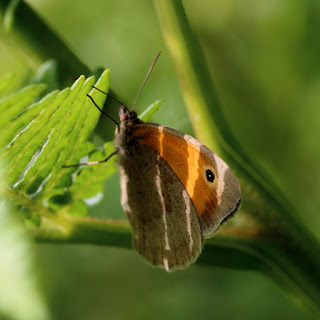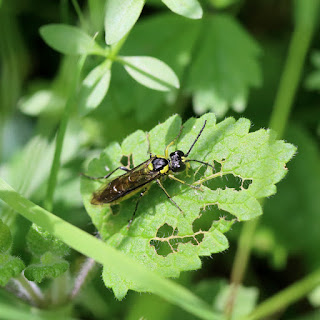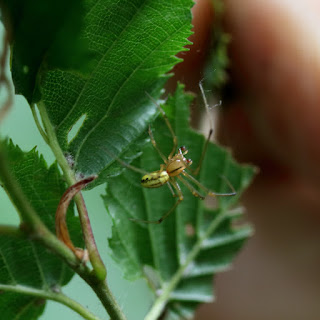For those unfamiliar with Rye Harbour - it is a small village with somewhere to moor boats, but locally it is renowned for its extensive nature reserve managed by Sussex Wildlife Trust.
Today we went for a walk led by Trevor Buttle round part of the reserve. The wildlife came thick and fast, starting before we left the car park when Maya found a Cream-spot Tiger moth (
Arctia villica britannica) outside the toilets.
Then came the flora - there are a number of 'always there' species on the entrance drive - like Sea Beet, Alexanders, and Hemlock. There was also a lot of Salsify. This is maybe a garden escape but it has seeded itself all along the drive and has now extensively colonized the bund wall. Here's a photo of one I took earlier.
Along the bund wall, and feeding on the nectar of the salsify was a male Early Bumblebee (
Bombus pratorum). This is one of our smallest bumblebees and is one of the first to establish a colony in the spring and the colony cycle is quite short, hence the emergence of a male before the spring is hardly out. Here's an example.
A big feature of every bramble patch we saw was the webby cocoons and the caterpillars of the Brown-tail moth (
Euproctis chrysorrhoea). The pretty adult moth is pure white but has brown tufts on the end of its abdomen, hence the name. The caterpillars have two bright orange dots on their back which serves as a warning not to touch as their hairs are a strong skin irritant.
On one of the empty cocoons, we found this striking spider
Tetragnatha extensa which even though it is common throughout the UK, doesn't warrant a common name apparently.
As we progressed through the reserve onto the shingle, some of the iconic Rye Harbour plants were much in evidence - Horned Poppy, Sea Kale (smells of honey to attract nectar-loving insects), Ivy-leaved Toadflax, Viper's Bugloss, and Hounds-tongue to name a few.
Another moth - the day-flying Yellow Shell (
Camptogramma bilineata atlantica) put in an appearance though it seemed reluctant to be photographed at first.
A visit to Rye Harbour at this time of year wouldn't be complete without a good display of nesting birds, and they didn't disappoint - Avocets and chicks were well represented as were Common and Sandwich terns, not to mention the raucous (and smelly) Black-headed gulls. We also caught a glimpse of some distant Little terns - lets hope that they are nesting here once again. When our ears weren't being assailed by noisy gulls, there were several skylarks to delight the ear as well as the call of a distant cuckoo.
A good walk. Thank you Trevor.
















































